|
Need Help?
|
|
Call
1-800-372-3706
to
speak to a Veterinary Behavior Technician |
|
Paws To Speak!
Member
Main Menu
|
 |
|
Help is at your
fingertips by library, email and
phone. |
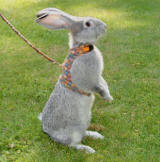
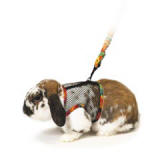
|
Can Rabbits Really Walk on a Leash?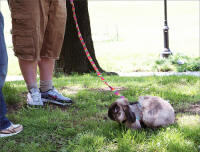
A question we have heard more than once, the answer is yes, but not in so many words. The reality is that rabbits are not going to trot along by your side, stopping when you do, and going where you want. However, they most certainly can learn to accept a harness and leash and will guide YOU where they want to go. Think of it more like walking WITH your rabbit rather than walking your rabbit.
The first main point to remember is that rabbits are extremely fragile. So care must be taken when starting this endeavor. Do not attempt to acclimate your rabbit to a harness or leash until your rabbit is completely comfortable being handled and touched all over by you.
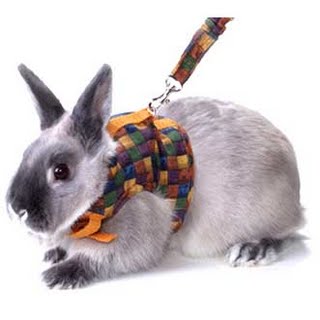 What type of harness do I need? What type of harness do I need?
You will need one of the following: a body harness, figure 8 halter, or figure H halter. All are sturdy, but lightweight. Make sure your harness fits properly. It should be snug, but not tight. If you can not find a harness specifically designed for a rabbit, such as the one pictured, a cat harness is usually your best bet.
Begin training your rabbit using baby steps. Show your Pet the harness and provide treats! Now, rub your rabbit all over with the harness while providing treats. Do this until they ignore the harness and just look for treats. Work up to placing the harness on your bunny, all while providing treats! If your rabbit seems nervous with any step, backup and proceed more slowly. Use treats liberally during the initial training process. 5-10 minutes, twice per day, for a week will usually make a rabbit comfortable wearing their harness. Don't be alarmed by a bunny who wants to chew through their harness. To prevent your bunny from destroying their harness, always use direct supervision and redirect their attention away from it with treats and a chew toy.
Once your rabbit is comfortable in their harness a leash can be added. It should be a bungee style, lightweight, and no more than 6 feet. Start out in the house or on a clean area of concrete. If grass is around, your rabbit will want to do nothing more than nibble. Place a treat a in your hand and show it to your rabbit, gently tug (very gently- more so guide) the leash toward the food, if your rabbit moves forward, give them their treat. Don't be surprised if your rabbit lays down, if this happens, simply wait, and reward your rabbit with a treat when they get up. Talk to your rabbit softly and be patient- learning to walk on a leash takes time.
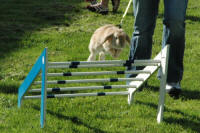 Go on small outings a few times a day for just a few minutes. Over a period of time your rabbit will start moving on his own and you can slowly phase out treats. Once treats are phased out be prepared to have a fun time walking with your rabbit, though it may only be a few feet at a time. Just enjoy the fresh air and being walked by your bunny, no matter how slow they are! Over time you and your rabbit may even be able to participate in an obstacle course like the bunny pictured! Go on small outings a few times a day for just a few minutes. Over a period of time your rabbit will start moving on his own and you can slowly phase out treats. Once treats are phased out be prepared to have a fun time walking with your rabbit, though it may only be a few feet at a time. Just enjoy the fresh air and being walked by your bunny, no matter how slow they are! Over time you and your rabbit may even be able to participate in an obstacle course like the bunny pictured! |
|